[ad_1]
While chickens are raised for different purposes – meat, eggs, show, and pets – I think we can all agree that it’s devastating to lose any members of your flock…
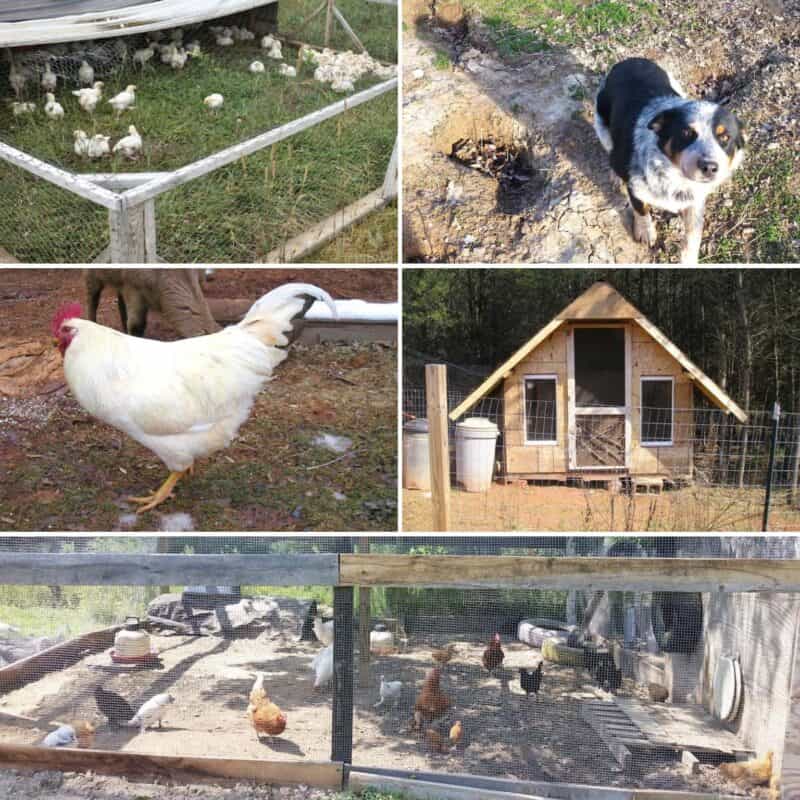
Hawks have keen eyesight to hunt from high in the sky, and sharp powerful talons to catch and carry chickens away. When a hawk sweeps in, the loss is almost always guaranteed.
Keeping your chickens safe from predators on land and in the sky requires good supervision and accommodation.
Losing chickens to hawks can be frustrating and often heartbreaking, but there are ways to keep your losses to a minimum…
In this article, I’ll explore 15 clever ways to protect your chickens from hawks.
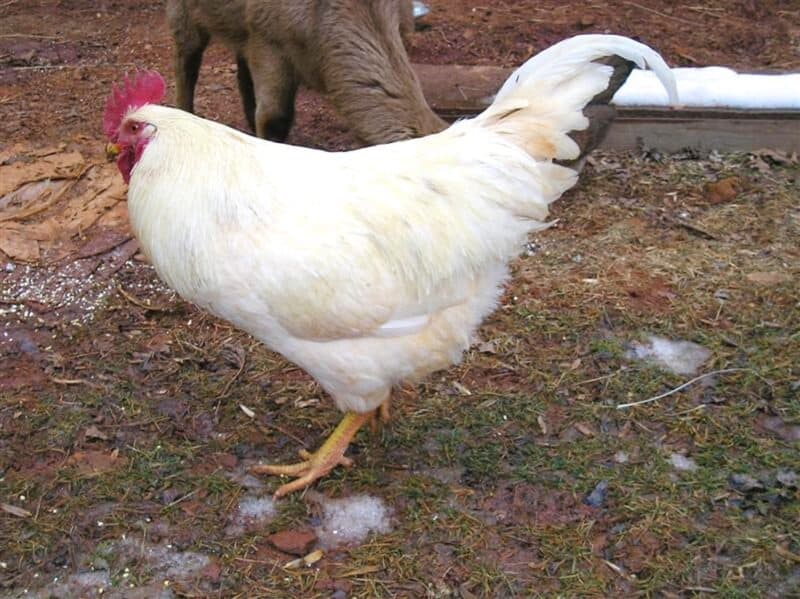
1. Add a Rooster
A rooster can be a valuable asset to your flock. They are very protective of their hens and spare no thought for their own safety in protecting them.
Adding an Orpington or a Polish Rooster can be a wise choice, they are the two noisiest breeds. Hawks are put off by loud noises, giving your chickens an extra layer of protection.
However, this is a buyer be warned chicken: if you don’t like noise, you may want to go with a different breed.
However, not even a rooster is safe from hawks, and they cannot be everywhere at the same time.
Their selfless protective nature is effective… to a point. But they are not a guarantee of protection.
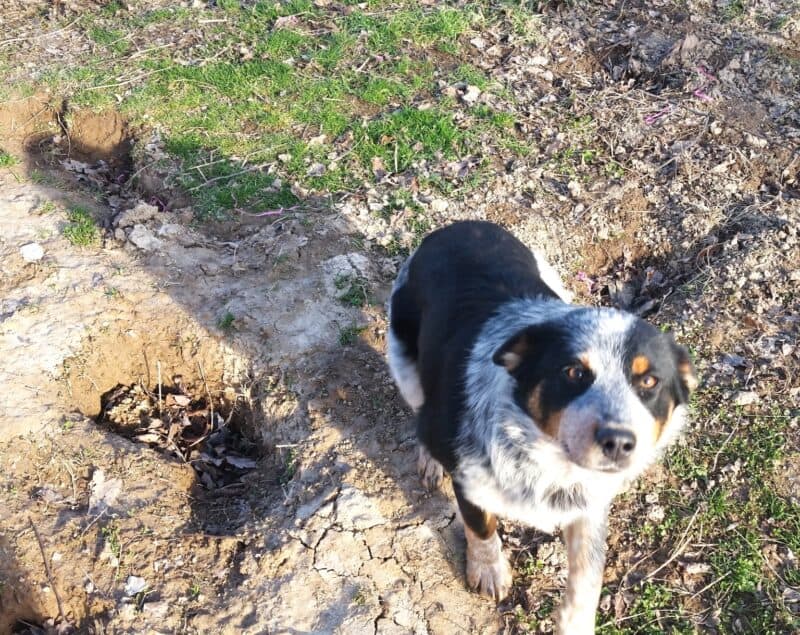
2. Guard Animals
Guard Dogs
Guard dogs can be good to produce noise and to attack any hawks that try their luck.
However, use common sense in choosing the right dog. Maltese poodles, yorkies, chihuahuas, and any small to medium breeds are just as likely targets of hawks as chickens.
If you have small dogs, they should be supervised when they’re outdoors.
The best breeds to protect chickens are:
- Old English Sheepdog
- Maremma Sheepdog
- Akbash
- Pyrenean mastiff
- Komondor
- Puli
Before you yell at your dog for simply watching as a hawk makes off with your chicken, remember that not all dogs are the same.
Some are tender and others – of the same breed – are territorial and vicious.
Guard Animals
You shouldn’t restrict your mind to a dog as protection from hawks. In fact, if your dogs are anything like mine, they’ll spend hours fast asleep on the job.
Almost any farm animal can be kept as a guard for your chickens. The key to success is a big and noisy one.
Include:
- Horses
- Cows
- Pigs
- Donkeys
- And even goats (not pygmy goats)
Including guard animals presents the hawk with confusion as the animals are unpredictable, moving around and making lots of noise.

3. Build a Strong Coop and Run
Straight up, a well-constructed coop and run are going to be the most effective ways to protect your chickens.
Your coop and run should have a roof and sides to protect your chickens from all angles, but the most important is the roof, as eagles hunt from high in the sky.
There are a few ways to secure your coop and run that are fairly cheap – other than the labor of love to set them up, that is…
Providing cover is not only good for keeping the hawks at bay, but is also helpful for the chickens by giving them shelter from the elements.
Build a Solid Roof
A good solid roof is ideal for your chickens as it will provide shelter from the weather and protection from hawks.
You can build a roof using shingles, plywood that’s covered by waterproof material such as a tarp, sheets of metal, corrugated iron, galvanized steel, or non-corrugated tin.
Tarps
A tarp provides good cover from all that mother nature can throw at your chickens from above.
Hardware cloth is a great option as it’s sturdier than conventional tarps, ground sheets, and painters’ tarps.
Use Chicken Wire
Chicken wire is inexpensive and is very effective in keeping hawks at bay.
Many land predators like raccoons, coyotes, weasels, and foxes will rip straight through the chicken wire, so if you’re looking for dual protection, chicken wire may not be for you.
Bird or Deer Netting
Bird or deer netting is a simple way to separate your chickens from airborne attacks.
The bright orange netting used to make visibility jackets is great because the hawks can see it and it masks a lot of movement underneath, so the hawks just move along…
Welded Wire
Welded wire is a foolproof way to protect your chickens from both land and air attacks. It will keep your flock safe from birds of prey and from other chicken predators who don’t burrow on the ground.
Fishing Line
Running fishing lines across the coop and run is very cheap and easy. You need to run the line in a diamond pattern with the lines less than 4 feet apart.
Hawks are less likely to try to maneuver through small openings as they are large birds.
The lines should be strung up about 7 feet off the ground.
Shade Cloth
Use a shade cloth to cover the chicken coop and chicken runs. It provides shade to your chickens and is a great barrier for birds of prey.

4. Scarecrow
Scarecrows can also help ward off birds of prey. Obviously, their big, looming, human-like features can cause hawks to think the chickens have a human watchdog.
However, the hawks will only be deterred for so long before they cotton on to the fact that this human will not run to aid the chickens.
For a scarecrow to be effective long-term you would need to move it around regularly.
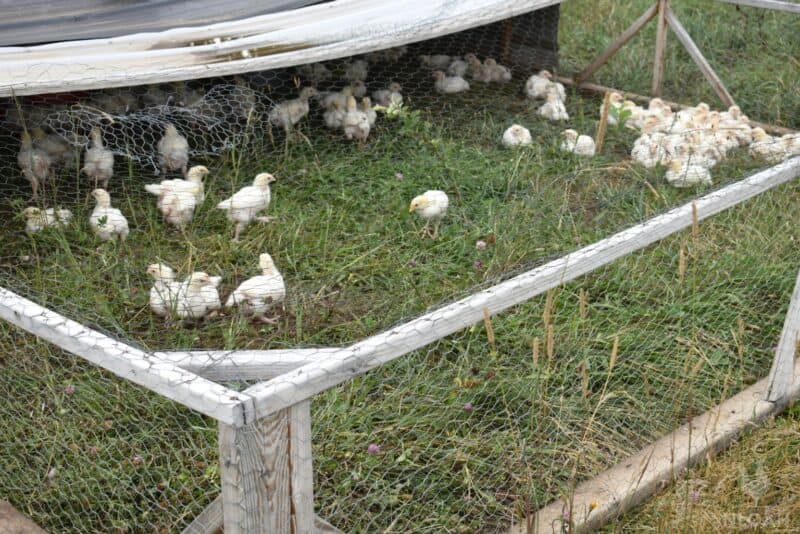
5. Use a Chicken Tractor
Chicken tractors are portable run/coops that can be moved around without any construction issues.
Essentially, a chicken tractor is a tent-like structure made from welded wire to cover the roof, walls, and floor (the floor is so that the chickens don’t run off while you are moving the tractor).
6. Stagger Routines
Predators quickly pick up on fixed routines. They will know when their would-be lunch is let out every day if they follow a set schedule.
Be flexible. Alternate keeping your chickens penned up and free to roam for a few days at a time. Let them out at different times of the day.
Change the environment every day in some way where your chickens are.
Move tables and chairs, hang laundered sheets, anything to discourage the hawks from an easy meal.
If you see a hawk, note the time, and try to keep your chickens inside at that time. If you have seen him, you better believe he has seen your chickens and is already setting the table for his next meal.
7. Disco Time
Hawks aren’t fond of any bright lights.
Whether it’s because it hurts their eyes or makes them think they’re being preyed upon by a bigger predator we will never know (unless one of my readers speaks hawk?
No… nobody? I guess the mystery remains).
Make dream catchers from aluminum plates, strips of foil, reflective tape, tins, old CDs, and old DVDs, and hang them out in the sun where the sun’s light can bounce around from reflective surface to reflective surface wherever your flock is.
8. Cover the Feed and Water Supply
The most vulnerable time for chickens to fall prey is when they’re eating or drinking.
The chickens are exposed and they aren’t focusing on anything but the food or water. This makes them easy pickings.
Make sure your feeders are covered up or where predators cannot get close.
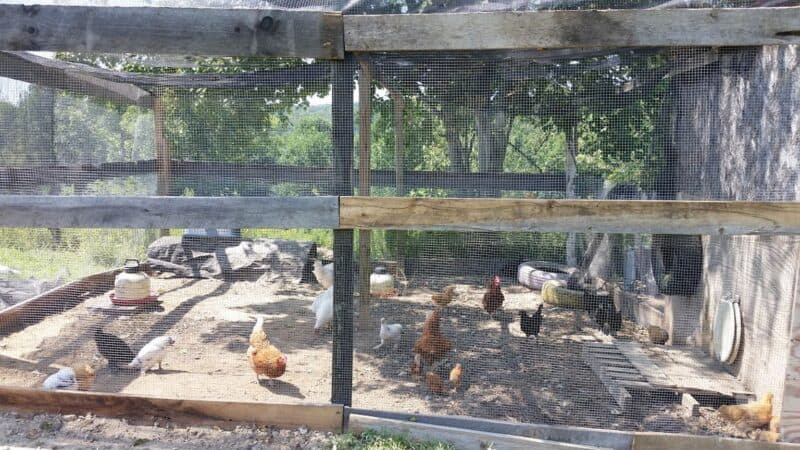
9. Improve Visibility
For any predator, the element of surprise is what makes them successful hunters.
Take away the cover provided by long grass and bushes, and you make it less likely for a hawk attack as the predator will be concerned about becoming the next meal of a sneaky land predator.
Don’t remove all the vegetation from an area, you still want someplace the chickens can run and take shelter under if they perceive a threat. Remove only long grass and excessive bushes.
Spring and Fall = More Hawks
Spring and fall are when you’ll see more hawks as the migration occurs.
The risk to your flock is greater during breeding season as the hawks need to feed their offspring and then teach them to hunt for themselves.
10. Supervise Your Chickens When They Are Out of the Coop
While it’s not always convenient to follow your chickens around all day, you make for a really good deterrent for hawks.
They know humans pose a threat and will therefore not carry out reckless attacks when people are around.
There are ways to make this work, though. Hawks are more likely to hunt in the morning than in the afternoon. Once they have their catch for the day, they return to their nests – this is normally before noon.
Do a little gardening in the morning with your chickens close by.
When the gardening is done, take time to read a good book, mow the lawn, break out the oil paints or sketch pads, or do something outdoors that brings you pleasure.
You should also make sure your chickens are safely locked in their coop by dusk in case of late afternoon munchies.
11. Hawks are Terrified of Owls
Hawks are good predators, but that doesn’t make them immune from other predators’ menus. Owls are scary to hawks because the hawk is a sought-after meal for owls.
Setting out owl decoys can only do so much. Like scarecrows, they need to be moved around regularly. Even if you do move them around, they’re far from a sure thing…
The best way to utilize owls will always be to utilize the real deal.
You can attract owls to your property by providing water to drink and bathe, leaving large patches of grass uncut to provide good hunting, and not cutting down big branches.
But the very best way to attract owls is to install nesting boxes. With a ready-made nest, hoot-a-hoo can resist?
12. Build a Chunnel
If you aren’t aware of what a chunnel is, it is a tunnel made – ideally – with welded wire.
It can be made of wood, chicken wire, and PVC piping, however, as mentioned earlier in this article, chicken wire doesn’t protect chickens from land predators.
You can run the chunnel any direction you want.
A chunnel provides a safe space for your chickens to exercise, and it protects your yard from chicken damage.
I like to build a few communal areas for the chickens to gather to scratch and sunbathe.
Building in several communal areas also means the chickens do not need to be on each other’s butts all the time.
If they want peace and quiet, they can move along to a more secluded space in the chunnel.
Remember to build in easy access panels for putting in fresh feeders.
13. Make Some Noise
Hawks really hate noise! The more noise around your chickens the better.
You should try playing a radio loud, setting up multiple wind chimes, hanging bells or tin cans in trees, attaching bells to your cows’ collars, or free-range noisy guard animals like pigs or cows with your chickens.
14. Encourage Crows and Ravens to Move In
Hawks don’t like crows and ravens. Crows and ravens will chase hawks away from their nests and will even attack them.
These two birds are extremely territorial and intelligent. Once they move in, they happily stay.
There are a few cons that crows and ravens bring. I must tell you that these are possibilities, they don’t apply to all crows or all ravens; these are all possibilities:
- They will steal your chickens’ eggs if they have the opportunity. Providing nests inside the coop will encourage hens to lay their eggs in a safer place.
- They can steal and eat chicks. They don’t bother with bigger chickens. If you can coop the chicks until they’re bigger – I would say protect them until they’re 5 to 6 weeks old – you definitely should.
They aren’t always effective as they can also be prey to a crafty hawk.
15. Old Wives Tale: Add a Black Chicken to the Flock
I’m sure that if you have asked around, you will have heard that you should introduce a black chicken or two in your flock to deter hawks.
The logic is that hawks hate ravens and crows, so will therefore stay away from the flock.
Well, most of us experienced folks will give at least a derisive snort at this advice. It’s true that hawks don’t like these two birds, but hawks are definitely not stupid.
They know what a raven looks like, and they know what a crow looks like. And they certainly know that a chicken, regardless of color or creed, looks just like dinner.
While every species has its own Darwin, most of the population is not a candidate for this prestigious award. You can try, but be forewarned, this is the least likely way to ward off hawks.
I hope these methods will keep your chickens safe from hawks.
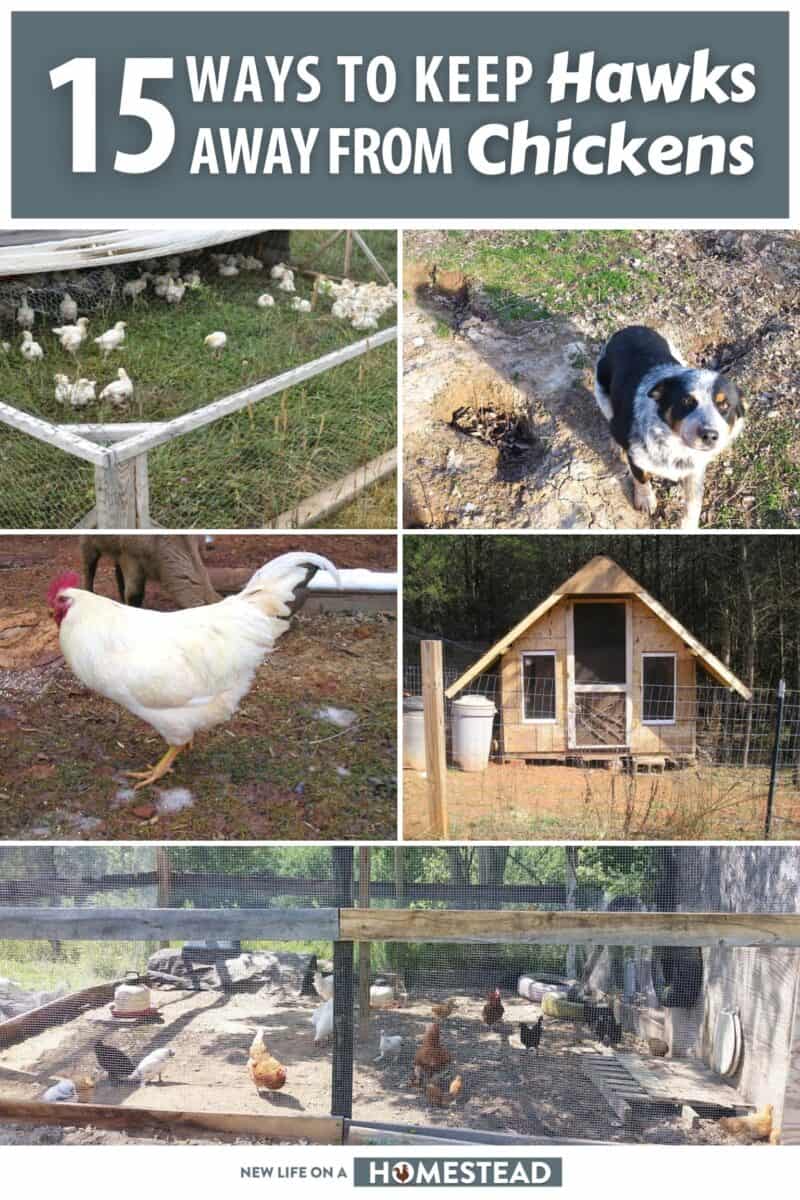
[ad_2]
Source link
Get more stuff like this
in your inbox
Don't Be Left Unprepared
Thank you for subscribing.
Something went wrong.




